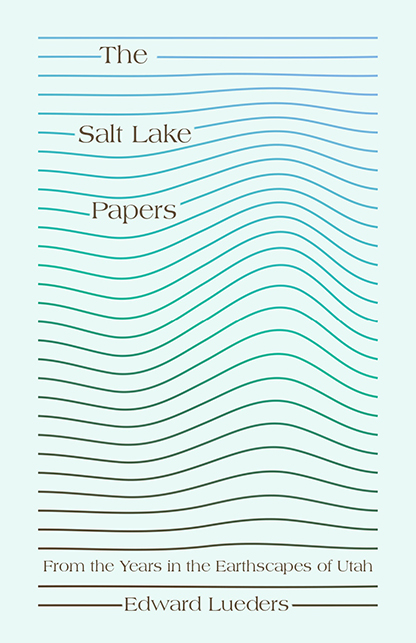Reviewed by Vicki Mayk
 If you are looking for a book that is full of what the author himself would describe as “stop and think about this” entries, this slim, 110-page creative nonfiction volume won’t disappoint. But if you are looking for an “easy read,” don’t pick up a copy of Edward Lueders’ The Salt Lake Paper: From the Years in the Earthscapes of Utah (University of Utah Press, 2018). Lueders, a retired English and creative writing professor who taught at the University of Utah, has written a book that reflects both his love of the earth and love of language.
If you are looking for a book that is full of what the author himself would describe as “stop and think about this” entries, this slim, 110-page creative nonfiction volume won’t disappoint. But if you are looking for an “easy read,” don’t pick up a copy of Edward Lueders’ The Salt Lake Paper: From the Years in the Earthscapes of Utah (University of Utah Press, 2018). Lueders, a retired English and creative writing professor who taught at the University of Utah, has written a book that reflects both his love of the earth and love of language.
The book is divided into two sections. The first, written in the 1980s but published for the first time in this volume, focuses on the Great Salt Lake, a presence that draws Lueders time and again. The second section includes his retirement to the Torrey-Capital Reef section of southern Utah, focusing on his affinity for the land there. It also contemplates the Colorado River system. Both sections are written in journal entries and notes rather than essays or long-form narrative. It is a style that lends itself to brief but profound observations on the environment, the digital age, language, and more that make up the book. The white space between each of these entries offers the mental pause that is needed to digest Lueders’ insightful writing. A reader needs to stop and think a moment before rushing on to the next.
Fans of Utah naturalist and author Terry Tempest Williams will appreciate Lueders’ fascination with and respect for the Great Salt Lake and the land surrounding it. He ponders its salinity, which keeps anyone afloat, as well as its shoreline and changing levels. “Who owns the Great Salt Lake?” Lueders asks his readers at one juncture, and from this question comes a series of entries that explore Americans’ relationship to the land. He challenges readers’ notion that land can actually be owned. In its natural state, it belongs to all. Citing the likenesses of former presidents carved into the landscape at Mount Rushmore, Lueders notes that “they express that part of the American character which finds and celebrates its identity with the land itself.” Book One is peppered with such observations.
Book Two, written more recently, focuses on the land in southern Utah where Lueders retired. This section opens with his statement, “In Salt Lake City I am in the world. In Torrey I am on the planet.” This quote sets the tone for ruminations on hiking—alone or with friends—and teaching writing classes against the backdrop of Capitol Reef Park. In that setting, light and shadow, vegetation, and the landscape are the writing prompts for the professor and his students. Lueders’ observations move beyond the natural world and include ruminations about music and rhythm (the writer is also a concert pianist) and about changes brought about by the digital age. Among the most thought provoking of those sections examines its effect on language and writing. At other times, his writing becomes highly personal, such as the section in which he writes of the sudden death of his daughter.
The Salt Lake Papers is difficult to categorize. Is it environmental writing? Science writing? Nature writing? Philosophy? Memoir? At times it is all of these. What it is, above all, is a book that challenges a reader to think. It poses questions and makes observations that call you back to re-read and re-consider. My review copy of the book boasts more than two-dozen Post-It flags marking passages that I will return to again. I can give the book no higher praise.
 Vicki Mayk is a memoirist, nonfiction writer and magazine editor whose work has appeared in print and online publications including Ms Magazine, Hippocampus Magazine, Literary Mama, and the Manifest-Station. Her book The Friends of Owen Thomas (working title) will be published in 2020 by Beacon Press.
Vicki Mayk is a memoirist, nonfiction writer and magazine editor whose work has appeared in print and online publications including Ms Magazine, Hippocampus Magazine, Literary Mama, and the Manifest-Station. Her book The Friends of Owen Thomas (working title) will be published in 2020 by Beacon Press.
Vicki is the editor of the magazine at Wilkes University, where she also teaches adult creative nonfiction workshops and a class about the power of story for freshmen.


